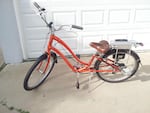
A standard bike turned electric bike using a conversion kit. E-bike adoption in China reached 200 million and is slowly growing in the U.S.
Stanstani/Wikimedia Commons
E-bikes are all the rage in other parts of the world. Quartz reports on some big milestones:
“The number of electric-powered bicycles in China just passed the 200 million mark, manufacturers are reporting 200 percent annual sales growth in Brazil, sales are strong in Europe and the Philippines is ordering 100,000 electricity-powered three wheelers, just one of several Asian nations investing in e-bikes.”
Here in the U.S. they are not nearly as popular and in some place they are not even welcome, says the Quartz piece:
“Although President George W. Bush signed a 2002 federal law that exempts electric bikes with speeds under 20 mph and less than 750 watts of power from state motor vehicle licensing requirements, individual states have introduced at least 47 different ways of clamping down on their use. The confusion has spawned websites to address questions like "Is my e-bike legal?, and helped to keep sales low. Of the 29.3 million e-bikes sold in 2012, just 53,000 were sold in the U.S., according to Navigant Research.”
I spoke to John MacArthur with Portland State University's Oregon Transportation Research and Education Consortium. He recently gave a talk about e-bikes in the U.S.
One thing he noted was that when comparing the U.S. to other countries, each place has different ‘standards’ for what’s considered an e-bike. In the E.U., anything with a throttle is not considered and e-bike, and in China, an e-bike might have pedals but operate mainly on electric, MacArthur said.
He had two opinions for why U.S. adoption of e-bikes is behind other countries:
- Overall number of people biking is low.
- The e-bike market has been slow to evolve.
On that front, the market is now evolving at an accelerated pace, MacArthur said. Perhaps innovations like there will get more people excited about e-bikes in the U.S.:
Designers are literally reinventing the wheel. Boston start-up Superpedestrian just got funding to begin producing it's Copenhagen Wheel, which replaces the rear wheel on any standard bike turning it into a self-powered hybrid electric bike.
A similar product in the prototyping phase is the snap-on FlyKly Smart Wheel. (If Kickstarter is any indication of potential success, the company has already gone over goal with over a month to go on their campaign.)
Currie Tech offers a whole line of electric mountain bikes.
On the higher-tech end of the spectrum there's the very slick, foldable and virtually unstealable Ncycle.
If you ride an e-bike, why do you, and what are the pros and cons? If you don’t have one, but wish to, what’s the barrier?
In the next week, I’ll follow up and share more about what I’ve learned about why people currently buy e-bikes and the e-bike research MacArthur has done.
-- Toni Tabora-Roberts